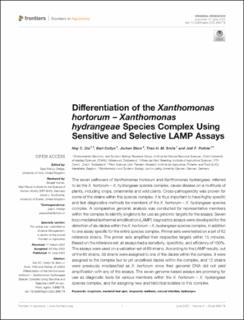Please use this identifier to cite or link to this item:
https://doi.org/10.21256/zhaw-25178Full metadata record
| DC Field | Value | Language |
|---|---|---|
| dc.contributor.author | Dia, Nay C. | - |
| dc.contributor.author | Cottyn, Bart | - |
| dc.contributor.author | Blom, Jochen | - |
| dc.contributor.author | Smits, Theo H. M. | - |
| dc.contributor.author | Pothier, Joël F. | - |
| dc.date.accessioned | 2022-06-24T14:04:36Z | - |
| dc.date.available | 2022-06-24T14:04:36Z | - |
| dc.date.issued | 2022-06-01 | - |
| dc.identifier.issn | 2673-3218 | de_CH |
| dc.identifier.uri | https://digitalcollection.zhaw.ch/handle/11475/25178 | - |
| dc.description | Related publications: https://doi.org/10.1099/ijsem.0.005163, https://doi.org/10.1002/ndr2.12008 | de_CH |
| dc.description.abstract | The seven pathovars of Xanthomonas hortorum and Xanthomonas hydrangeae, referred to as the X. hortorum – X. hydrangeae species complex, cause disease on a multitude of plants, including crops, ornamental and wild plants. Cross-pathogenicity was proven for some of the strains within this species complex. It is thus important to have highly specific and fast diagnostics methods for members of the X. hortorum – X. hydrangeae species complex. A comparative genomic analysis was conducted for representative members within the complex to identify singletons for use as genomic targets for the assays. Seven loop-mediated isothermal amplification (LAMP) diagnostics assays were developed for the detection of six clades within the X. hortorum – X. hydrangeae species complex, in addition to one assay specific for the entire species complex. Primer sets were tested on a set of 62 reference strains. The primer sets amplified their respective targets within 15 minutes. Based on the reference set, all assays had a sensitivity, specificity, and efficiency of 100%. The assays were used on a validation set of 60 strains. According to the LAMP results, out of the 60 strains, 39 strains were assigned to one of the clades within the complex, 9 were assigned to the complex but to yet undefined clades within the complex, and 12 strains were previously misclassified as X. hortorum since their genomic DNA did not yield amplification with any of the assays. The seven genome-based assays are promising for use as diagnostic tools for various members within the X. hortorum – X. hydrangeae species complex, and for assigning new and historical isolates to this complex. | de_CH |
| dc.language.iso | en | de_CH |
| dc.publisher | Frontiers Research Foundation | de_CH |
| dc.relation.ispartof | Frontiers in Agronomy | de_CH |
| dc.rights | https://creativecommons.org/licenses/by/4.0/ | de_CH |
| dc.subject | Singleton | de_CH |
| dc.subject | Bacterial leaf spot | de_CH |
| dc.subject | Diagnostic method | de_CH |
| dc.subject | Natural infection | de_CH |
| dc.subject | Hydrangea | de_CH |
| dc.subject.ddc | 572: Biochemie | de_CH |
| dc.subject.ddc | 579: Mikrobiologie | de_CH |
| dc.title | Differentiation of the Xanthomonas hortorum – Xanthomonas hydrangeae species complex using sensitive and selective LAMP assays | de_CH |
| dc.type | Beitrag in wissenschaftlicher Zeitschrift | de_CH |
| dcterms.type | Text | de_CH |
| zhaw.departement | Life Sciences und Facility Management | de_CH |
| zhaw.organisationalunit | Institut für Umwelt und Natürliche Ressourcen (IUNR) | de_CH |
| dc.identifier.doi | 10.3389/fagro.2022.898778 | de_CH |
| dc.identifier.doi | 10.21256/zhaw-25178 | - |
| zhaw.funding.eu | No | de_CH |
| zhaw.issue | 898778 | de_CH |
| zhaw.originated.zhaw | Yes | de_CH |
| zhaw.publication.status | publishedVersion | de_CH |
| zhaw.volume | 4 | de_CH |
| zhaw.publication.review | Peer review (Publikation) | de_CH |
| zhaw.funding.snf | 177064 | de_CH |
| zhaw.webfeed | High Performance Computing (HPC) | de_CH |
| zhaw.webfeed | Umweltgenomik | de_CH |
| zhaw.funding.zhaw | Xhortomics: Entwicklung von diagnostischen und epidemiologischen Hilfsmitteln für die Xanthomonas hortorum Spezies Gruppe basierend auf OMICs Technologien | de_CH |
| zhaw.author.additional | No | de_CH |
| zhaw.display.portrait | Yes | de_CH |
| Appears in collections: | Publikationen Life Sciences und Facility Management | |
Files in This Item:
| File | Description | Size | Format | |
|---|---|---|---|---|
| 2022_Dia-etal_Differentiation-Xanthomonas-hortorum-X-hydrangeae.pdf | Article | 3.12 MB | Adobe PDF |  View/Open |
| 2022_Dia-etal_Differentiation-X-hortorum-X-hydrangeae_Suppl.zip | Supplementary Material | 17.1 MB | Unknown | View/Open |
Show simple item record
Dia, N. C., Cottyn, B., Blom, J., Smits, T. H. M., & Pothier, J. F. (2022). Differentiation of the Xanthomonas hortorum – Xanthomonas hydrangeae species complex using sensitive and selective LAMP assays. Frontiers in Agronomy, 4(898778). https://doi.org/10.3389/fagro.2022.898778
Dia, N.C. et al. (2022) ‘Differentiation of the Xanthomonas hortorum – Xanthomonas hydrangeae species complex using sensitive and selective LAMP assays’, Frontiers in Agronomy, 4(898778). Available at: https://doi.org/10.3389/fagro.2022.898778.
N. C. Dia, B. Cottyn, J. Blom, T. H. M. Smits, and J. F. Pothier, “Differentiation of the Xanthomonas hortorum – Xanthomonas hydrangeae species complex using sensitive and selective LAMP assays,” Frontiers in Agronomy, vol. 4, no. 898778, Jun. 2022, doi: 10.3389/fagro.2022.898778.
DIA, Nay C., Bart COTTYN, Jochen BLOM, Theo H. M. SMITS und Joël F. POTHIER, 2022. Differentiation of the Xanthomonas hortorum – Xanthomonas hydrangeae species complex using sensitive and selective LAMP assays. Frontiers in Agronomy. 1 Juni 2022. Bd. 4, Nr. 898778. DOI 10.3389/fagro.2022.898778
Dia, Nay C., Bart Cottyn, Jochen Blom, Theo H. M. Smits, and Joël F. Pothier. 2022. “Differentiation of the Xanthomonas Hortorum – Xanthomonas Hydrangeae Species Complex Using Sensitive and Selective LAMP Assays.” Frontiers in Agronomy 4 (898778). https://doi.org/10.3389/fagro.2022.898778.
Dia, Nay C., et al. “Differentiation of the Xanthomonas Hortorum – Xanthomonas Hydrangeae Species Complex Using Sensitive and Selective LAMP Assays.” Frontiers in Agronomy, vol. 4, no. 898778, June 2022, https://doi.org/10.3389/fagro.2022.898778.
Items in DSpace are protected by copyright, with all rights reserved, unless otherwise indicated.